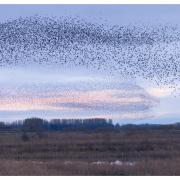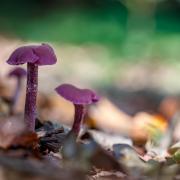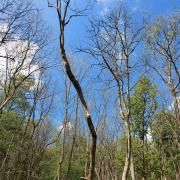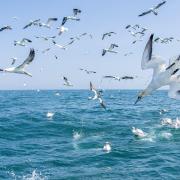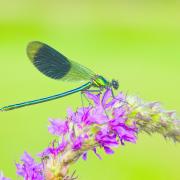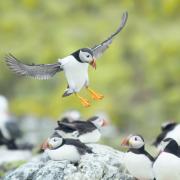Tom Marshall from the Yorkshire Wildlife Triangle shows how you can spot our slithery friends.

There’s something a little unnerving about seeing a snake in Britain for the first time. All the classic features are there; the diamond-shaped markings, the forked tongue dancing in front of a pair of blood-red eyes and a slightly increased heart rate that suggests you’re not quite sure what its next move will be.
For some, the very idea that there are snakes in Yorkshire at all may be enough to come over all Indiana Jones and start waving around a flaming torch. For the rest of us, it still seems remarkable that that such a wide range of warm-blooded creatures can make a home so far from the equator.
It is however, the cooler weather of early spring at these northern latitudes that provides perhaps the best chance to get close to our native reptiles as they wake from their winter slumber. From adders to grass snakes and lizards too, they’re quite literally chilling out.
For the past few months, these scaly residents have been sheltering in their rather grandly-named ‘hibernacula’ – piles of rocks, rubble, compost heaps or anywhere with a steady ambient temperature. As the days grow longer, they rise with the gradually warming sun and venture out.

Adders are typically the first to emerge, with the males often appearing in March and sometimes even in late February, spending the weeks until April shedding their dull winter skin in favour of a rich black and green attire. The female adders follow soon after, stunningly well concealed when curled-up against the rusty-red brackens of winter in their chocolate brown and burnt orange jacket.
These seasonal serpents typically prefer dry, exposed areas with a south facing aspect and vegetation that provides a good balance of protective cover to slip into, but opportunities to spread out and maximise exposure to the vital blood-warming spring sunshine. Heathlands like Skipworth and Allerthorpe near York, and large conifer woodlands like those of Dalby Forest provide just such conditions.
Despite the reputation of their Hollywood cousins, adders are generally shy and elusive – blending remarkably well into the undergrowth. To that end, and despite being our only venomous snake, they offer little threat unless deliberately provoked or accidently trodden on. To enjoy them is simply a matter of common sense – if you keep a respectable distance there’s memorable behaviour to be witnessed, including for the very lucky, the entwining and enchanting adder dance.
Sadly, like so many creatures who are often vilified after displaying what is in fact natural behaviour exhibited when they are under threat, adders remain a reptile that teeter on the conservation brink, always at the mercy of a constantly changing countryside.

Hot on the scaly tail of the adders are the supporting cast of other British reptiles from the common lizard (often on the adder’s lunch menu), to slow worms and grass snakes.
More often than not, a snatched glimpse of a ‘common’ or viviparous lizard is the classic, did I or didn’t I? A closer inspection of a sun-drenched rock or the shady side of a nature reserve boardwalk may find you with coming eye-to-eye with these harmless miniature dragons. A moment or two of patience after a rustle in pathside grasses may be rewarded as they struggle to resist the warming rays and re-appear in short, split-second bursts of movement.
Not only one of the most northerly of the reptiles, its viviparous characteristics mean it in fact gives birth to live young, unlike the majority of other reptilian counterparts. The uplands of the Yorkshire Dales and North York Moors offer plenty of opportunity for common lizards, while Strensall Common near York is a popular location too.
Rather less abundant and remaining something of a mystery in terms of its status in Yorkshire is the slow worm. In fact a legless relative of the lizard, its shiny, metallic appearance looks like a miniature-scale snake, with another classic feature being the presence of eyelids (unlike many other reptiles).

Also keen on grassy heaths and sun-drenched spots, the slow worm can equally have a penchant for larger gardens and allotments, where compost heaps make a great hideout.
Perhaps the biggest fan of compost heaps however, is the grass snake. These metre long garden neighbours probably offer your best chance of an encounter with a reptile in Yorkshire – as they’re our largest – and rather helpfully, non-venomous to boot.
Usually an attractive olive green, but lacking the tell-tale diamond markings of an adder, they often have a pale yellow or cream ‘collar’ behind the head.
With a somewhat Catholic diet that includes frogs and toads (and even the odd fish) at one end, and small mammals, eggs and small birds at the other, the grass snake has mastered that art of adapting. Its party trick though, is a confident swimming prowess, no doubt a handy skill when the menu is such a smorgasbord of life in the undergrowth.
There’s no surprise then, that Yorkshire’s wide range of wetland nature reserves are popular spots to seek out a sunbathing grass snake. With that liking for compost heaps, piles of grass and hay, basking atop these high-rise residences is all in a day’s work.
A great area is Yorkshire Water’s Tophill Low, or the Wildlife Trust’s Potteric Carr (where grass snakes have been seen swimming in the pool in front of the new visitor centre) along with Staveley, near Harrogate or Sprotborough Flash in South Yorkshire.
Indeed, many nature reserves now intentionally leave these metre-high grassy pyramids in suitable spots, which grass snakes not only use for basking, but also raising their young due to the heat generated inside.
So whatever your opinion of Yorkshire’s reptiles, why not put your fears aside this month and make sure they’re not your last wildlife crusade.
What to look out for this month
This month the cuckoo flower or ‘lady’s smock’ brings bursts of subtle pinks to wet spring meadows. Thought to coincide with the arrival of that more traditional harbinger of longer days the cuckoo, these early blooms are welcomed by some of the first butterflies to hit the wing, such as the orange-tip.












